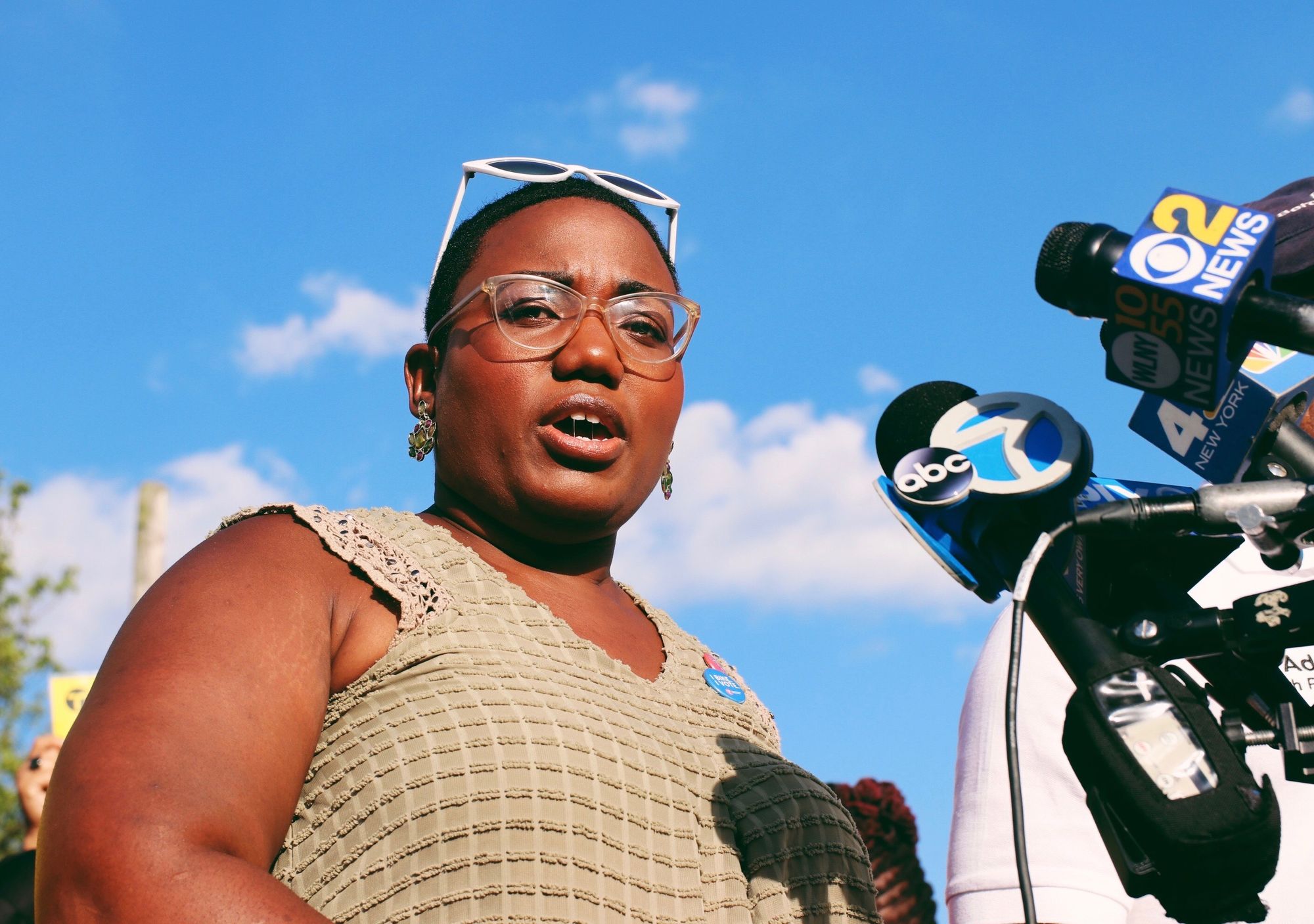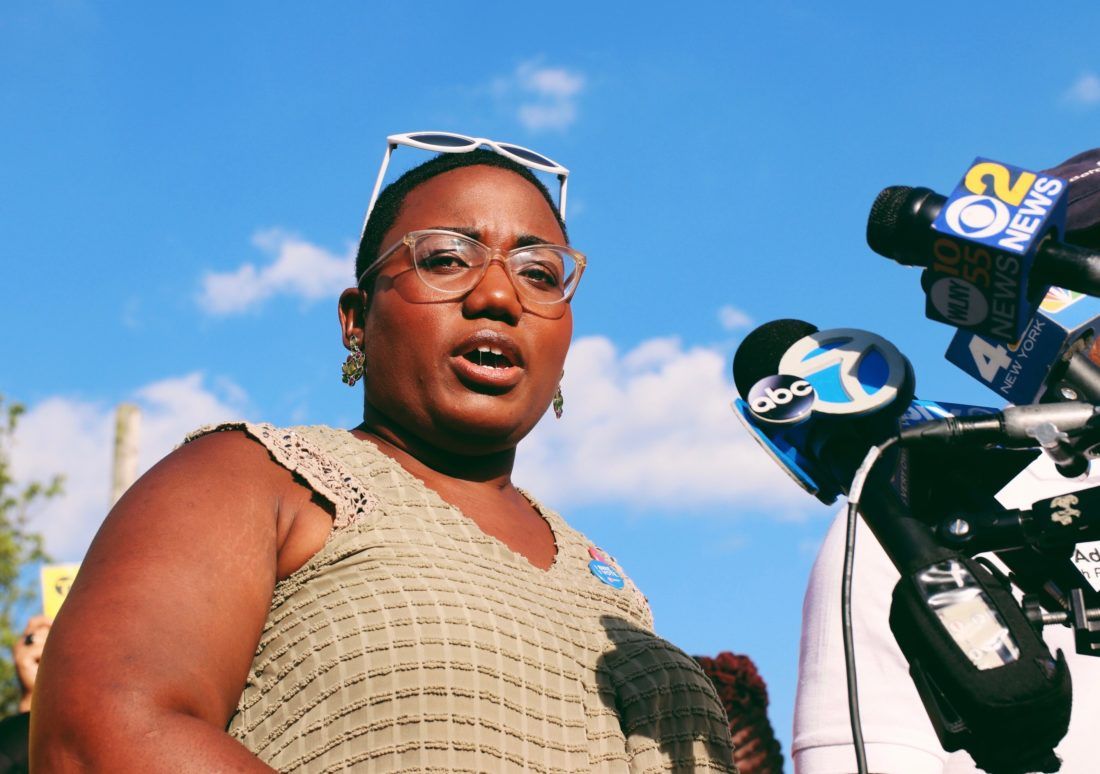@BrownBikeGirl On Bike Lanes, White Guys, And Educating All


CLINTON HILL — A few years ago Courtney Williams was unemployed and about to leave New York City.
“I remember putting up the posters trying to leave the city, trying to sell stuff out of my apartment, and a voice inside my head was like, ‘Ride over the Brooklyn Bridge,” she told Bklyner in an interview. “It must have been my first time, because it seemed momentous.”
On the Brooklyn bridge, she encountered a family biking.
“We rode all the way up and she offered me a job while we were riding. She was like ‘You’re the kind of person who should work for my company,” Williams, 34, recalled. “I got a job while biking.”
Williams — who is from Indiana and lives in Clinton Hill — worked at a Small Business Services contractor for five years, then quit to start The Brown Bike Girl, a consulting business that promotes cycling in communities of color, in 2016. Now, if you go to an event involving biking in New York City, it’s likely you’ll see Courtney Williams there.
“I started Brown Bike Girl because I was already passionate about cycling,” she said. “I was finding more and more that people of color were totally unaware of the advocacy organizations that existed or the bike education and I was like, ‘This shouldn’t be.’ So I started the consulting organization project so I could help organizations that already exist do better to connect with people of color and let them have more prolific bike lives.”
A graduate of University of Cincinnati’s urban planning program, Williams admires the work bike advocacy groups do, but noticed the mostly white male-led groups had shortcomings when it came to bringing non-white cohorts into the fold.
“Organizations are comfortable where they are a lot of the time, or their base does not value equity pursuits. So you’ll have groups of people who are dominantly white male and they don’t necessarily see the value in diversifying their organization or their group because this is work you have to do,” Williams explained. “It makes sense that people don’t try harder, because it’s hard, but also a lot of organizations are funded in ways that do not incentivize them to do that along racial and social lines.”
“Let’s say you’re a nonprofit and your nonprofit is funded to do some social good, but you’re doing well, you’re lauded already, people think you’re doing a great job, but you happen to only be serving one half of the population,” she went on. “There’s no incentive for you to go farther and incorporate brown people to deal with the various social issues because why? You’re already funded, you’re cushy, so people don’t.”
But the struggle to get people of color to embrace biking—and the infrastructure that promotes it—don’t stop at the majority-white advocacy groups. Often times, proposals to install bike lanes are thought of as yet another sign of gentrification in historically non-white neighborhoods, much like a new shiny housing development with oversized windows or a bespoke coffee shop.
At a Community Board 9 meeting in June, when the Department of Transportation (DOT) presented its Flatbush Avenue bike lane, Williams preemptively countered the notion that a bike lane is a sign of gentrification and should be fought.
“Bike lanes don’t sell out communities, your elected officials do. And they do it decades before the bike lanes show up,” she said, adding that “DOT is not here to [raise] property values.”
“It’s a logical but wrong conclusion for communities of color and those who are concerned about displacement,” Williams told Bklyner of gentrification concerns about bike lanes.
Williams said that when people in neighborhoods that are “traditionally deprived” of bike infrastructure see something that “only exists in places that are predominantly white,” it leads people to believe that “bike lanes are being built for somebody else.”
“You should not resist the bike lanes because of why you think they’re coming; you should accept the bike lanes because of what they can do for whoever is present, which is save their lives,” Williams said.
And not only is it not beneficial for black and brown communities to fight bike lanes tooth and nail, but supporting safe biking is especially beneficial to them, she says.
“Neighborhoods of color, people of color, they have more to gain because they’re further behind socially, economically, because they were put there by policy,” Williams said.
“To overcome a lot of these setbacks, I believe it would be beneficial if we also have the ability to cycle, because I believe cycling is a cure-all to almost everything,” she said with a laugh.
“We don’t have world-class facilities on every street to keep every cyclist, every pedestrian safe, and we should,” Williams said of bike infrastructure in low-wealth neighborhoods at a vigil for Ernest Askew, a cyclist who was killed by a motorist in Brownsville in July.
Vigils for killed cyclists are far from a rarity in 2019. Nineteen cyclists have been killed by motorists’ on the city streets this year, 14 of them in Brooklyn.
In response to the spate of cyclists deaths, Mayor Bill de Blasio rolled out a “Green Wave” plan aimed at keeping bike riders safe in the coming years. Williams, of course, was there for the announcement and was underwhelmed by the plan.
“It’s sort of like, ‘Thank you for writing down what should have been written years and years ago,’” she said, adding the initiative included “too many half steps.” “I don’t think it’s an adequate plan.”
Williams trusts the DOT to implement sound changes to street design, and feels as though the mayor isn’t pushing through the plans they know to work as aggressively as he should be. More broadly, Williams says the city too often “pussyfoots around when it comes to making changes that they know will upset the majority,” and should not heed the opinions of the disproportionately older pro-car community board members at the expense of bike safety.
“They won’t allow what needs to happen as far as the implementation of safety measures like bike lanes,” she said. “They’re not qualified to have that level of input. Somebody boldly needs to come along and say ‘Nah, this is out of your jurisdiction, we’re going to do this.’ … Community boards should not have say over safety.”
“The majority are not experts,” she said. “That’s why experts are experts.”
Williams, though, is not interested chiefly in the ins and outs of the processes that dictate into where new bike lanes go or don’t go.
“There’s the set of advocates who are really good at looking at street design and that’s what interests them the most. What interests me the most is making people feel able to deal with what they have, and that’s why I do education the most. Because there will not be a bike lane on every street of New York anytime soon—so let’s deal with the reality we have,” she said. “Let me give you the knowledge to be your best first defense, to give you the sense where to bike, where not to bike, the risks to take, and the risks not to take.”
“That’s what I give to people because that’s what will keep them alive and that’s what I contribute to averting the crisis.”